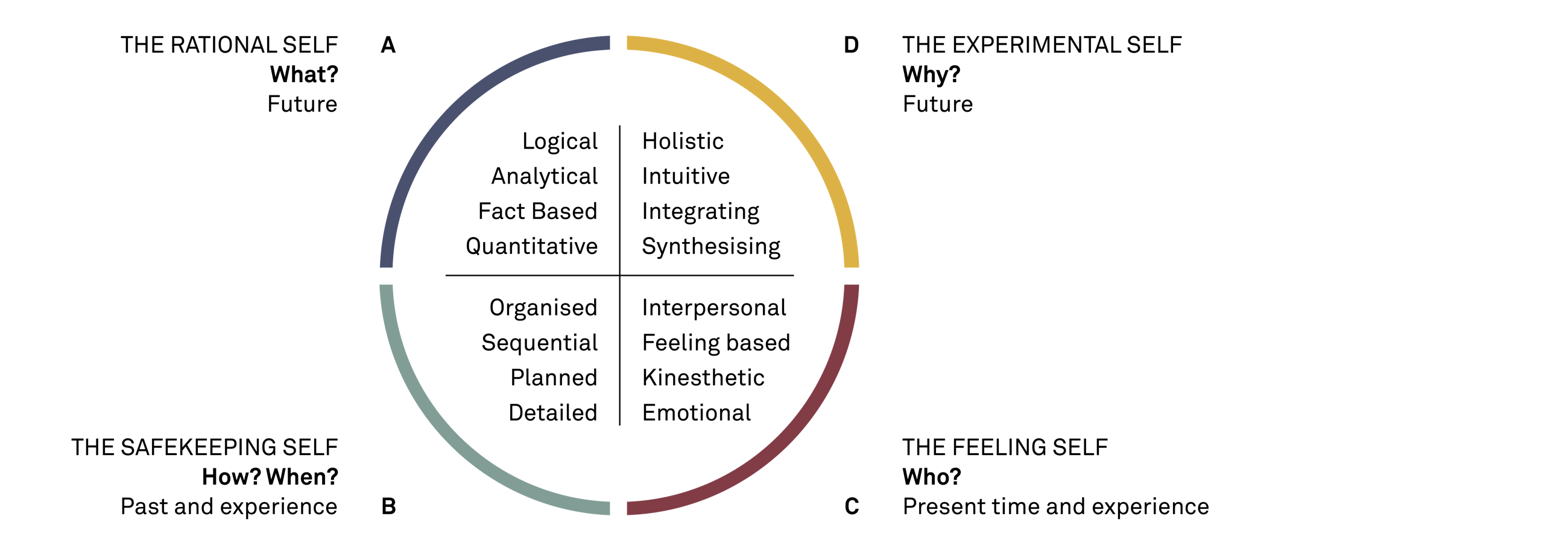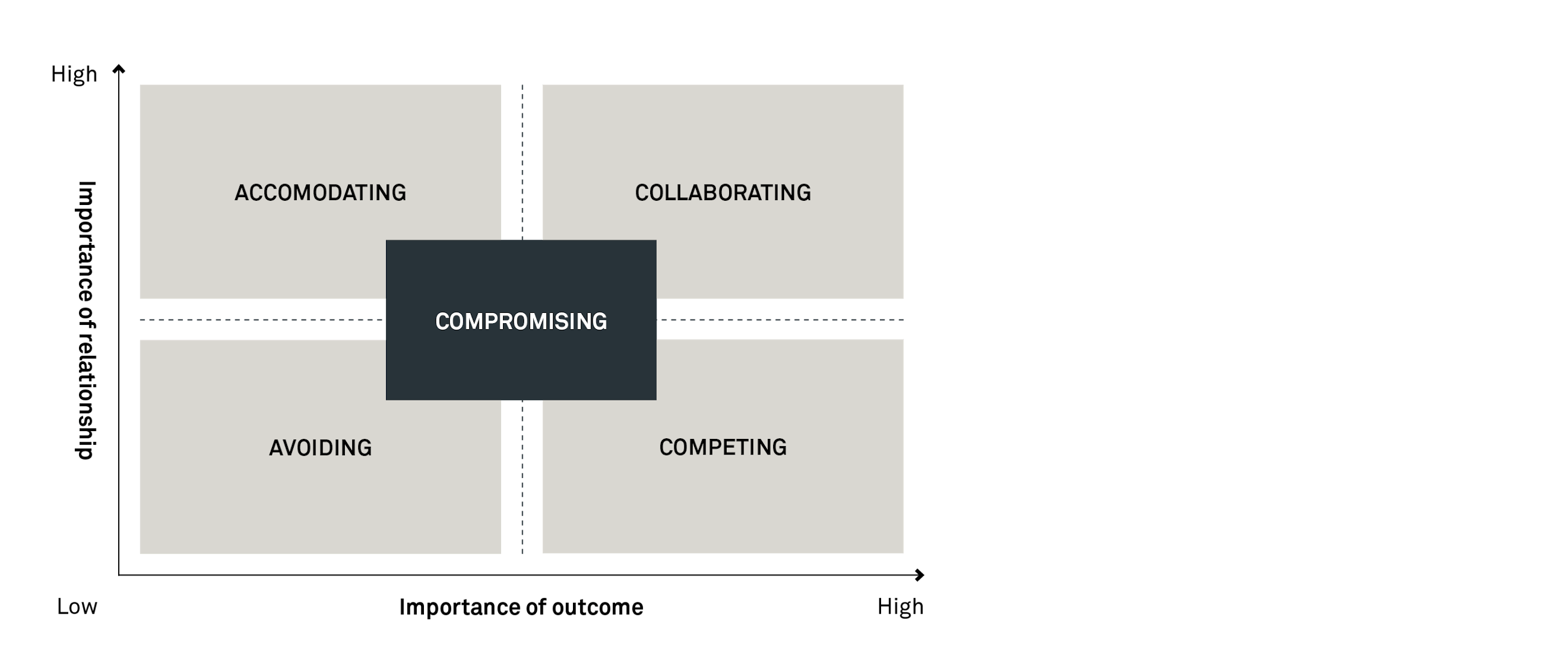Strategic choices and preferences in negotiation
15 November 2015
If you encounter conflict from across the table in a negotiation, it could be caused by your own behaviour! While this might be a bold statement, it is often true in corporate negotiations.
Many negotiations are seen as a poker game to be won rather than a collaborative process where relations and behaviour are paramount, and where reaching an agreement is mutually satisfying. In poker-game negotiations, the normally equalising concept of “win-win” has a different meaning: There is only one winner and one loser.
Much research, however, suggests that there is a great deal more to a negotiation than just putting on a poker face and discovering the other person’s “tells”.
In this article, we present how to significantly improve your negotiation skills and strategies to reach results that are mutually beneficial. We discuss the Herrmann Brain Dominance Instrument® (HBDI), also known as the Whole Brain® Model, which is a powerful thinking style assessment tool used in corporations and organisations worldwide. This model helps people understand their own thinking preferences and related behaviour patterns. It helps identify someone’s overall brain preference profile, and used in conjunction with a basic model for choosing the negotiation strategy, we will illustrate how subconscious thinking preferences affect the conscious choices of strategy in negotiations.
Perhaps most importantly, we show how knowing and understanding preferences can greatly improve negotiation skills and strategies and the ability to rapidly adapt your strategy to other people’s preferences.
Why use the Whole Brain® Model in negotiations?
Negotiation is an important element in organisational life, and every day people and companies negotiate both internally and externally to reach agreements, solve disputes or create new opportunities. For various reasons, negotiators often settle for results poorer than what is obtainable ; they “leave money on the table”.
But a good negotiation is characterised by leading to an agreement that cannot be mutually improved, by a process that is as efficient as possible and which strengthens or simply maintains the existing relationship between the parties. There should be no money left on the table, no wasted excessive resources spent in the process of agreeing, but trust that the other party will honour the agreement. The Whole Brain Model will help you do just that.
Try to imagine, for instance, that you are a supplier for a large company, and that you are waiting in the reception for a meeting to finalise a major purchase contract. The receptionist offers you a coffee and walks you to the meeting room where the purchase manager politely and attentively asks about your journey. Now, imagine the same situation without a helpful receptionist with hot coffee, a purchase manager who is 30 minutes late and who barks that unless your company can offer an additional discount of 5 %, the meeting is off. Due to the differences in how the company constructed the pre-meeting and the frame of the negotiation, most of us would probably be affected positively in the first example and negatively in the second.
A good start provides the basis for a good agreement. Negotiation is a social construct where preferences and the way our brain is hard-wired influence our perceptions. Maybe you do not like coffee, maybe the purchase manager had a good reason to be 30 minutes late, maybe you like punctuality, and maybe you like a good atmosphere. In all likelihood, your preferences will influence your emotions as well as the unconscious choices you make during the process.
Sub-optimal agreements often occur because both parties are unprepared, approach the whole negotiation situation inappropriately, or get caught up in positional bargaining – instead of working to create value for both. The quality of negotiations and the end result increases significantly, both financially and measured on relations, when the negotiator becomes more attuned to personal preferences – and is able to adapt this knowledge to his choice of strategy.
Overview of the Whole Brain Model
But what is this Whole Brain Model ? The model was developed by Ned Herrmann in the 1970s and has been used for more than 35 years. It is based on neuropsychologist Roger Sperry’s split-brain research for which he shared the Nobel Prize in Medicine in 1981. His model is loosely based on an evolutionary brain theory proposed by neuroscientist Paul MacLean. Ned Herrmann created a very simple and memorable model that helps people understand how they think and how they can use their whole brain.
The Whole Brain Model identifies a person’s thinking preference based on dominance between four distinctly different thinking modes controlled by the left, right, cerebral and limbic parts of the brain. In the original work of Ned Herrmann, these four thinking loci create four individual modes of thinking known as:
- Analytical (blue)
- Sequential (green)
- Interpersonal (red) and
- Imaginative thinking (yellow).
The model indicates a person’s communication, learning, problem-solving and decision-making preferences. No Whole Brain profile is good or bad, right or wrong – it merely indicates a person’s preferences.
A person can normally think in all four modes, but will often be stronger in just one or two. And this preference often affects his or her behaviour. For instance, a person most likely to think analytically will often be good at collecting data and at critical and logical reasoning, while he/she might be less attuned to sensory input or expressing ideas.
Remembering this simple model is useful when getting ready for any negotiation. Knowing the agenda, knowing the relationship between the negotiators and knowing their preferred thinking styles can improve the likelihood of reaching a beneficial agreement. Even the first step of a negotiation (deciding an agenda) will be highly influenced by the negotiator’s preferred style, and, thus, knowing this style would be helpful.
A negotiator with a strong sequential preference (green) would probably have sent you the agenda long before a negotiation, while the negotiator with a preference for imaginary thinking (yellow) may have decided to skip the agenda all together and seek to create a mutual vision at the beginning of the meeting – only to change it 30 minutes later. A negotiator with a strong preference for analytical thinking (blue) would most likely focus on factual analysis and outcome, and finally, a negotiator with a strong preference for the interpersonal thinking (red) would probably focus on the long-term relationship as the goal of the negotiation. Negotiators can agree or disagree due to their preferences. Here, the rational (blue) preference is outlined.
The blue preference outlined shows how he or she would be comfortable negotiating with a person who shares his/her preferences and be emotionally challenged by people of different thinking patterns and preferences.
To conclude
Knowing personal preferences as well as clues to the preferences of the other party allows for an effective negotiation team to be formed (matching the partners to meet), it provides important information on how best to prepare and structure the negotiation process, and it helps guide the best psychological behaviour as well as frame the negotiation environment to maximise the chances of a good agreement.
Negotiation strategies: How to master dual concerns in negotiation
While a well laid-out negotiation plan is important, successful negotiation is also a matter of understanding its context. This means adopting the best approach and being able to switch strategy depending on the situation. In the Dual Concern Model, proposed by Roy J. Lewicki and Alexander Hiam in 2006, we see how negotiators in fact use five basic strategies based on their needs and wants: avoiding, accommodating, competing, collaborating and compromising.
Negotiators may use all five strategies without even thinking about it, but they may also choose one or more because of their personal preferences in the Whole Brain Model and the immediate situation.
The Dual Concern Model is helpful when attempting to reach the best outcome in a negotiation and shows how different strategies might be employed depending on the negotiator's concerns and priorities (outcome vs. relationship).
The avoiding strategy means that the negotiator neither sees the relationship nor the outcome as important, often leading to withdrawal from active negotiation. However, it is often chosen simply to win time, for example if a buyer knows that a supplier is planning to announce price increases.
The accommodating strategy means renouncing your own concerns to focus on the overall outcome and to meet the needs of the other side, even if the negotiator will likely achieve a poor negotiation result. This strategy could be necessary in a salary negotiation with a key employee when the manager estimates that the relationship and motivation of the employee is more important than the extra cost of a salary increase.
The competing strategy is used when there is a high concern for your own outcome and less for relationship. This strategy usually does not emphasise the creation of total value, but may be effective in negotiations with few items to discuss, for example if the concern is only about price when an organisation is buying commodities or in transactions where you are unlikely ever to deal with the person again.
The collaborating strategy is often used when additional value is desired. When being collaborative, both parties recognise that they need each other, have mutually vested interests and seek to find creative solutions to satisfy interests which in turn create more value for both.
The last strategy, the compromising strategy, sits in the middle of both dimensions. Compromising typically leads to splitting the difference among the parties. This often happens in the end of a negotiation or when a negotiator is concerned with fairness rather than result.
Combining the strategies of the Dual Concern Model with the preferences of the Whole Brain Model, we can refine negotiation skills and techniques. Negotiators can benefit by strategically choosing the best of the five strategies contained in the Dual Concern Model. They can then use their Whole Brain profile and knowledge to communicate and act in a way that best suits the preferences of those involved in the negotiations. For instance, if one (blue) negotiator prefers well-reasoned propositions, it is easier to get approval when using clear precise logic rather than communicating through metaphors and visions (yellow). In another instance, if the focus of a negotiator is on the relationship between the parties (red), it is more effective to talk about the relation (red) between the parties rather than looking into the many details of the issue being negotiated (green).
As stated, most negotiators use more than one strategy. Different situations lead to different concerns and a variety of strategies throughout the negotiation. The knowledge of preferred thinking patterns and well thought-through choices of strategy will likely lead preparation and the negotiation itself to better results.
Strategic negotiation with the Whole Brain Model
It would be safe to say that very few negotiators link their negotiation performance – and that of the persons on the other side of the negotiation table – to their own thinking preferences. But raised awareness of personal thinking preferences is an essential part of understanding your own reactions when negotiating. Gaining insight into your preferences also makes you more sensitive to the preferences of others. It is important for instance when forming the negotiation team and identifying roles and responsibility – and when you plan and execute tailor-made negotiation strategies. It will equally help you choose and prepare a positive environment and to act in a way that matches the preferences of the other party.
You are much less likely to let subconscious behaviour and emotions drive you, and you will understand what happens when your mindset changes. Some examples are when you become annoyed and want to leave (money on the table), become stimulated and want to continue and create value, become bored and lose focus on the variables or perhaps become over-enthusiastic and ready to enter into unattractive deals.
As part of advising and training negotiators, Implement Consulting Group uses Whole Brain profile and negotiation strategy tests to help negotiators get a better understanding of both negotiation style as well as personal preferences. The increased awareness of personal and team preferences, strengths and weaknesses also highlight areas of improvement. It provides negotiators with a powerful tool when planning future negotiation strategies with the aim of reaching the best agreements and ensuring strong and lasting relationships.







